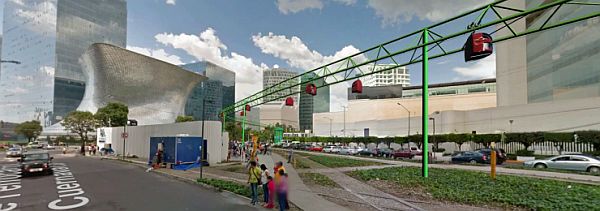Traffic jams in Mexico City are among the worst in the world. The rush-hour madness has forced Chilangos, as Mexico City residents are known, to come up with all sorts of creative fixes over the years—from elevated highways to no-drive days for older vehicles.
But now Mexico wants to get over its traffic problem altogether. Literally.
Mexico City's ministry of science, innovation and technology this year is expected to launch a revolutionary prototype for a new public transit system that kinda looks like a fancy ski lift suspended above the streets.
Each gondola unit will be fully automated and can be individually programed to whisk users directly to their final destination without making local stops, according to project planners.
The system, known as the "Personalized Elevated Urban Transport" (or TUEP in Spanish), promises to move some 37 million people across the city each year, and up to 200 million if the system is extended to longer distances.
"The TUEP gondolas will travel at a speed of 9 miles per hour and each of them will have two seats to make this transportation method more personal," explains a press release. The design and technology behind the system is being pitched as 100% Mexican. Developers also claim it could provide a more efficient alternative to taking the bus or subway. "It will also allow the user to save time, because unlike the subway or the metrobus, passengers can program their final destination at the start of their trip," said Luis Rodolfo Zamorano, the engineer behind the project.
Zamorano told Fusion that his prototype testing will be completed by March. Then plans will begin to build the first 3-mile stretch of monorail, complete with 1,000 gondolas. He says the first phase will require an initial investment of $46 million from public and private partners, as well as a series of concessions from the city.
Local politicos appear to support the idea; Mexico City has already ponied up more than $2 million to support the prototype.
Zamorano claims private investors from the U.S., Spain and The United Arab Emirates have also shown interest in the project, which would cost Mexican users around 50 cents for a 3-mile ride— approximately 20 cents more than the average inner-city bus ride.
The transportation rail will also operate an elevator running on "gravitational energy" that promises to slash the city's energy costs.
"When you look at a normal elevator, it needs to overcome gravity through an electrical motor," Zamorano explains. "What we are doing is not trying to fight gravity, but use it in our favor."
Although the fate of the project is still up in the air, the TUEP seems to be the kind of big, innovative idea that the city needs to lift it into the future.
Original article


